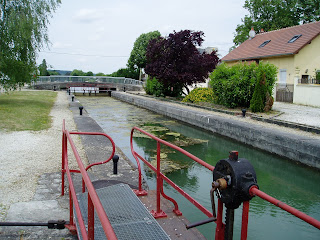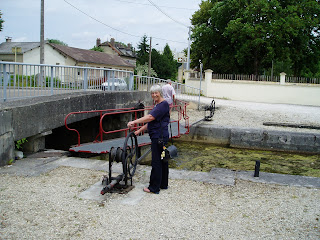Succumbing to the curse of the newly retired - that there is always so much to do that it gets in the way of doing it - we abandoned more adventurous expeditions and went for a four day spin down the Grand Union to Blisworth.
There are no locks for many miles along the GU between Foxton and the Watford staircase, with only the tunnel at Crick to interrupt the view, but what a shock that is after dreamily floating between banks of green trees and creamy meadows. There are seven locks, four of them forming a staircase and though it can be done in 40 minutes there is usually a queue of half an hour or more before you enter. There is an excellent and supportive volunteer lock keeper who keeps things in order, guiding, helping and encouraging. More details of Watford Locks here.
South of the locks there is a curious stretch where the main west coast rail line rushes past, a road bridge carries the M1 overhead and Watford Gap service station can be seen through the trees. The railway follows the canal along for several miles and I am reminded that Watford Gap is in fact a real gap in low hills originally followed by grazing animals, then by nomadic early man and in time became the obvious place for a major road, canal and train line north.
We arrived at Norton Junction at 7pm in time for a satisfactory meal at the New Inn, Buckby Wharf.
Next day we spent most of the morning negotiating the arduous locks of the Buckby Flight - seven substantial locks and very hard work, heavy and spread out. Their main advantage is being double width so if possible lock up with someone else to share the strain.
And so we arrived, suitably warmed up, at Whilton Marina at mid-day, though this is a business trading boats rather than a place for mooring up. We paid our respects to the excellent chandelry which does basic food too as well as a copy of The Independent to gladden John's heart, and continued on our way south.
Here is a further stretch of 15 miles without a lock to arrive at Blisworth in good shape in 71/2 hours. Our knowledge of arrangements at Blisworth was enhanced by details from a very well informed CRT man at Gayton Junction and the CRT workshop who ran through the approach to Blisworth as if replaying a film. It's great to know that there are folks who are experienced and can tell you everything about their local patch.
We last saw Gayton on our way down the Nene and up to Welford last year but the short mile or two from Gayton to Blisworth was new territory. We'd already decided not to go on to Stoke Bruerne as it wasn't worth ploughing through the 13/4 mile tunnel then having to return almost immediately, but we needed assurance that there were moorings and turning space at Blisworth. We need not have worried - as our expert explained, there is ample space up to 60 feet or more by the Canal Company moorings and many moorings on the approach to the town - which itself has a pub and shops.
In fact we moor first near to the Canal Company and a warehouse converted to flats, trot down to the tunnel entrance "just to see", in to the village to check out shops and The Royal Oak (popular local, rather noisy) then decide to moor further back away from the town, nearly at bridge 49, and nearer to The Walnut Tree, suggested as a better eatery.
A brisk walk takes us to The Walnut Tree which was once The Station Hotel, in the days when Blisworth was a popular railway junction. Now it stands rather isolated but worth a visit as we had a very good meal served by efficient and friendly staff.
As night falls we continue to be serenaded by frequent rushing trains in the background, but otherwise this mooring is peaceful and calm.
And so to the reverse journey, leaving Blisworth at 8.30, arriving Long Buckby at 1pm and reaching the New Inn at 3pm. We crack on and finally moor at Crick at 6.15 with a good meal at The Red Lion in the village.
Day four is a straightforward and relaxing trip back to Welford by lunchtime, when we scoff the remains of our food and do some washing and painting work on Patience. Quite a lot of time on the canal but good boating in pleasant conditions with long light evenings. Given that we started out in chilly rain with one or two boats having their fires on, that's a good finish!
There are no locks for many miles along the GU between Foxton and the Watford staircase, with only the tunnel at Crick to interrupt the view, but what a shock that is after dreamily floating between banks of green trees and creamy meadows. There are seven locks, four of them forming a staircase and though it can be done in 40 minutes there is usually a queue of half an hour or more before you enter. There is an excellent and supportive volunteer lock keeper who keeps things in order, guiding, helping and encouraging. More details of Watford Locks here.
South of the locks there is a curious stretch where the main west coast rail line rushes past, a road bridge carries the M1 overhead and Watford Gap service station can be seen through the trees. The railway follows the canal along for several miles and I am reminded that Watford Gap is in fact a real gap in low hills originally followed by grazing animals, then by nomadic early man and in time became the obvious place for a major road, canal and train line north.
We arrived at Norton Junction at 7pm in time for a satisfactory meal at the New Inn, Buckby Wharf.
Next day we spent most of the morning negotiating the arduous locks of the Buckby Flight - seven substantial locks and very hard work, heavy and spread out. Their main advantage is being double width so if possible lock up with someone else to share the strain.
And so we arrived, suitably warmed up, at Whilton Marina at mid-day, though this is a business trading boats rather than a place for mooring up. We paid our respects to the excellent chandelry which does basic food too as well as a copy of The Independent to gladden John's heart, and continued on our way south.
Here is a further stretch of 15 miles without a lock to arrive at Blisworth in good shape in 71/2 hours. Our knowledge of arrangements at Blisworth was enhanced by details from a very well informed CRT man at Gayton Junction and the CRT workshop who ran through the approach to Blisworth as if replaying a film. It's great to know that there are folks who are experienced and can tell you everything about their local patch.
We last saw Gayton on our way down the Nene and up to Welford last year but the short mile or two from Gayton to Blisworth was new territory. We'd already decided not to go on to Stoke Bruerne as it wasn't worth ploughing through the 13/4 mile tunnel then having to return almost immediately, but we needed assurance that there were moorings and turning space at Blisworth. We need not have worried - as our expert explained, there is ample space up to 60 feet or more by the Canal Company moorings and many moorings on the approach to the town - which itself has a pub and shops.
In fact we moor first near to the Canal Company and a warehouse converted to flats, trot down to the tunnel entrance "just to see", in to the village to check out shops and The Royal Oak (popular local, rather noisy) then decide to moor further back away from the town, nearly at bridge 49, and nearer to The Walnut Tree, suggested as a better eatery.
 |
| Duncan at Blisworth Tunnel entrance (north entrance) |
 | ||
| Warehouse flats, Blisworth |
 |
| Leaving Blisworth Tunnel north entrance |
 |
| Network of railways including Blisworth, dated 1911. Larger version here. |
As night falls we continue to be serenaded by frequent rushing trains in the background, but otherwise this mooring is peaceful and calm.
And so to the reverse journey, leaving Blisworth at 8.30, arriving Long Buckby at 1pm and reaching the New Inn at 3pm. We crack on and finally moor at Crick at 6.15 with a good meal at The Red Lion in the village.
Day four is a straightforward and relaxing trip back to Welford by lunchtime, when we scoff the remains of our food and do some washing and painting work on Patience. Quite a lot of time on the canal but good boating in pleasant conditions with long light evenings. Given that we started out in chilly rain with one or two boats having their fires on, that's a good finish!




